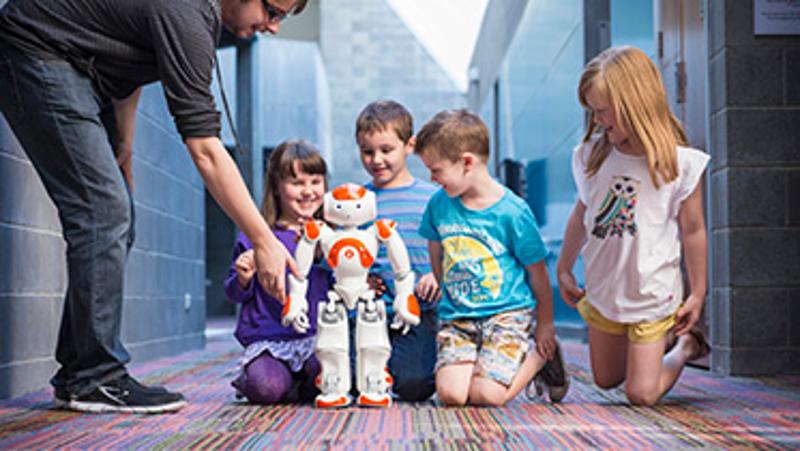
A world in which we share our homes and workplaces with robots is upon us - and this pint-sized android is helping prepare us for both.
QUT roboticists and their fleet of Nao (pronounced 'now') robots are pioneering a new method of programming machines - one in which any person can speak commands that a robot can understand and act on.
It's called natural language programming, and QUT roboticist Professor Jonathan Roberts believes it's a key to bringing robots into everyone's world - be they serving customers or helping seniors live independently.
"Currently, to program a robot you need to be proficient in computer languages - coding," said Professor Roberts, from QUT's Science and Engineering Faculty and the Australian Centre for Robotic Vision (ACRV).
"That kind of system limits who can direct a robot, and therefore to what uses that robot can be put.
"If we want our robots to truly help us in the home and workplace then all of us will require the ability to instruct them.
"Just as the Jetson family could tell their robot housekeeper what to do, natural language programming will allow anyone to instruct a robot to do almost anything just by speaking to them."
Robotics PhD student Gavin Suddrey is pioneering the research that will make natural language programming a robotic reality.
His passion is aged care. Gavin sees a future in which humanoid robots like Naos will perform the simple tasks around the house that allow the elderly to live independent in their homes for longer.
"I think Naos and others like them are best suited to home environments and older demographics because their cute and friendly looks are quite relatable and they tend to put people at ease," Gavin said.
"My research is centred on developing a system where you teach a robot a task by literally talking them through the steps involved in much the same way as you might teach a toddler.
"Even the simplest of tasks for a human can be broken down into a series of sub-tasks that combined become a complex process for a robot to learn.
"Take answering a phone, for instance.
"First you would instruct the robot to walk to the phone when it hears it ringing.
"Once it's learned that instruction, you add the next step - walk to the phone and reach for the receiver. And so on.
"Once the robot has been taught all the sub-tasks, you can then tell it to perform all those instructions in sequence whenever you say the words 'answer the phone'."
QUT is participating in the newly funded Innovative Manufacturing Cooperative Research Centre. One of its research programs will focus on the applications of robotics in manufacturing industries and workplaces.
According to Professor Roberts, natural language programming will pave the way for robots in work environments with humans and where the tasks are constantly changing.
"The simpler and less technical the programming process, the more valuable those robots will be to employers and human coworkers," Professor Roberts said.
"The combination of natural language programming and robotic vision - using cameras to see and interpret the world as we do - is really the holy grail of an effective robotic workforce."
Leading technology companies like Google, Amazon and Boeing are already pouring billions of dollars into their robotics divisions.
Professor Roberts said having workplaces in which humans can easily instruct their robotic colleagues would likely change the nature of the work humans undertake.
And, while not all of us will require high-end robotics expertise in the workplace, the robot revolution will create whole new categories of careers and opportunities for humans who are skilled at working with robots.
QUT's Naos are already recruiting that future human workforce.
"Our Naos are pivotal to the ACRV's high school outreach program to encourage high school students to consider a degree in robotics," Professor Roberts said.
"The robotics revolution is going to spawn whole new industries and careers we haven't even dreamed of yet.
"The world will need millions of highly-skilled humans to design, develop, direct and maintain our robotic co-workers.
"Our Naos are a key STEM education tool to get that future workforce comfortable working with robots, programming robots, inspired by robots."
The public can come face-to-face with Naos, and even learn some Tai Chi moves from them, at QUT's Robotronica festival on August 23.
The free event will showcase a wealth for world-first robots and technology from QUT and around the world, including artist Neil Harbisson, the world's first certified cyborg.
For more information and to book now for workshops visit the Robotronica website.
RELATED STORIES
Robotronica: come and meet the future
Eco robots - smart solutions to protect our environment
Do you see what I see? Meet the team giving robots an insight into being human.
World-first open online robotics courses for the masses
Media contacts:
Kate Haggman, QUT Media, 07 3138 0358, kate.haggman@qut.edu.au
After hours Rose Trapnell, QUT Media team leader, 0407 585 901.




